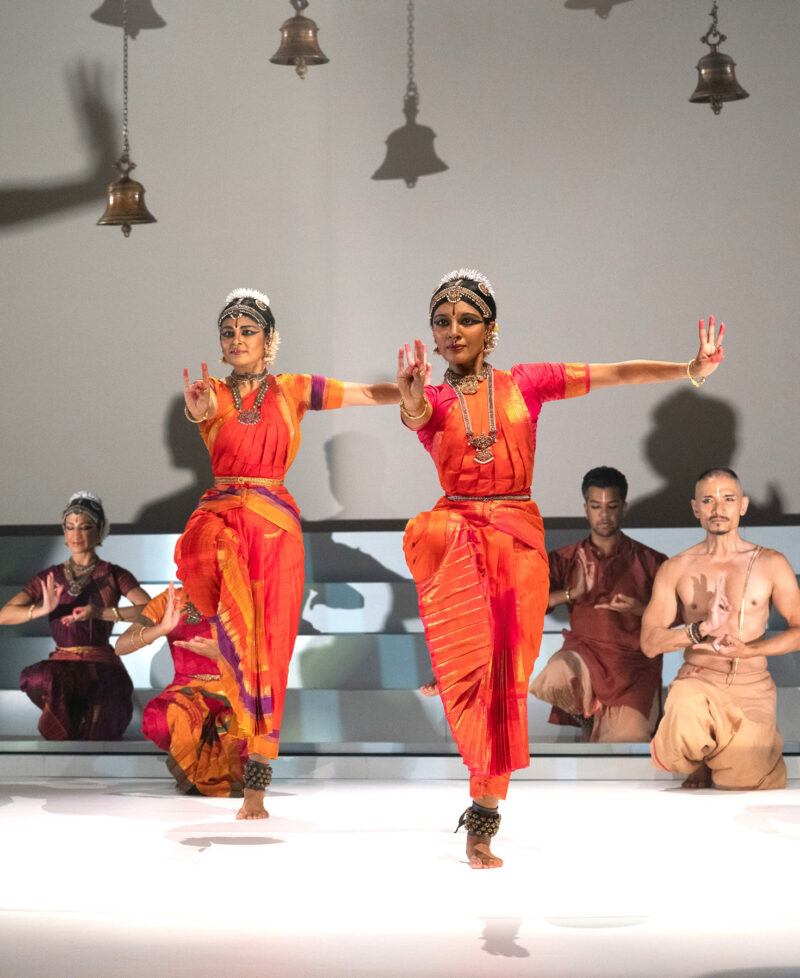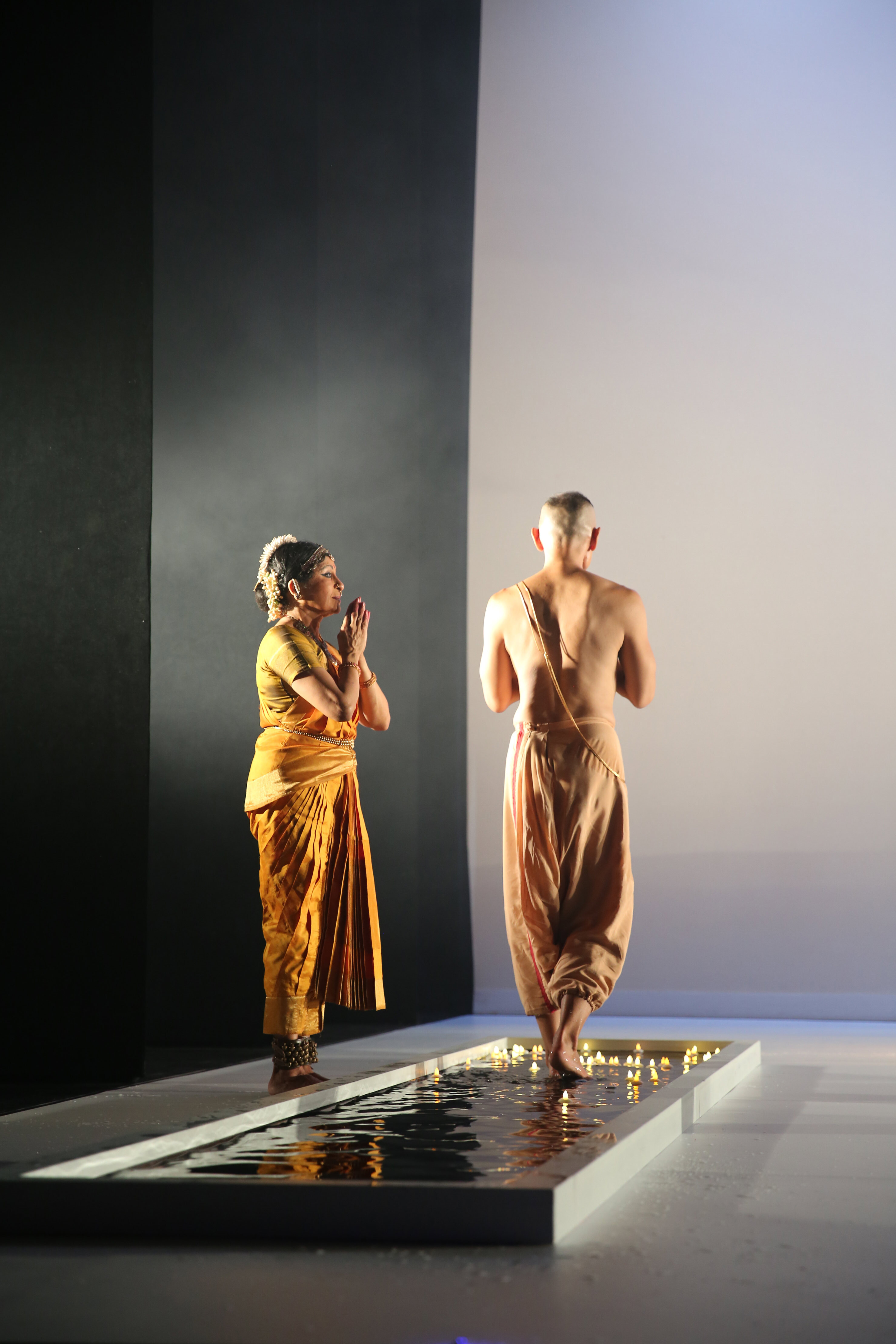"Fires of Varanasi: Dance of the Eternal Pilgrim": Through the Eyes of an Inexperienced Viewer
Review of Ragamala Dance Company at the Meany Center for the Performing Arts
Written by Teen Writer Josephine Bishop and edited by Disha Cattamanchi

The curtain rose to reveal an unlit stage. Fifteen bells hung at varied lengths from the ceiling, and three shallow pools of water were dispersed, mimicking the famous Ganges River. A dancer silently pushed out candles into the water, unhurriedly lighting the stage with a serene atmosphere. This opening set the mood for Ragamala Dance Company’s phenomenal performance.
Founded in 1992 by South Indian-American dancers Ranee Ramaswamy and Aparna Ramaswamy, the Ragamala Dance Company aims to connect the past and present through Hindu tradition and cultural expression. The dance company has toured all around the United States, India, and abroad, with the dance form Bharatanatyam, a prominent South Indian dance form originating from Tamil Nadu. As an art form, Bharatanatyam transports the audience through a spiritual experience informed by Hindu principles and mythology. At the Meany Center for Performing Arts, the dancers performed Fires of Varanasi: Dance of the Eternal Pilgrim, choreographed by acclaimed dancer Alarmél Valli. The show centers around the dancers embarking on a pilgrimage, built on the belief of reincarnation.
It's hard to say what's better, coming into a performance knowing all there is to know about it or coming into it with a fresh slate. Due to my almost non-existent experience with dance, I was apprehensive to set any expectations for this show. Despite this, I was eager, as well as mildly intimidated, at the idea of analyzing such a complex art form. The only dance performances I had seen included my family’s annual trip to The Nutcracker between the ages of seven and ten, when I routinely slept through the entire thing. Going into this performance was evidently very different; not only was it of my own volition, but I also knew nothing about the history of Bharatanatyam. This prompted me to stay attentive in order to comprehend the intention behind each scene, and how it played into a larger purpose.
The performance included eleven dancers that moved in total synchrony. The dancers’ moves were very sharp. For the most part, their legs were stiff and at an angle, their arms held up in the air; I could only imagine how taxing this was to maintain. Despite the rigid positioning, the choreography looked elegant and fluid. Stomping their feet, they would also simultaneously wave their hands, or gesture with their fingers. Throughout this undoubtedly arduous dance, the performers never stopped smiling, their facial expressions never wavering; this contributed to a positive and animated mood. Together the dancers portrayed an emotive, vibrant, and spirited choreography.

Throughout the performance, I admired the absence of props. With the choreographed formations, the dancers became decorative. Some were on the side of the stage, making ripples in the water, while others performed the main dance in the center. This created an engaging and dynamic scene that occupied the full span of the stage. The choreography never overtly communicated the purpose of the story; rather, you had to infer the emotion of the scene yourself. This was challenging in the beginning, though I became more invested as the show continued, gaining a deeper understanding of the message and sentiment behind the dance.
Eventually the music quieted and the lights dimmed, with one dancer ascending a large staircase to ring the dangling bells. All eleven dancers pivoted to face one side of the stage, light radiating onto them, casting their shadows across the theater. This was one of the few moments throughout the show where the lighting was fully utilized. I became used to seeing the bright, lit-up stage, so the stark change to complete darkness made an impressive impact.
Something I noticed about the dancer’s costumes were the bold colors. Their sarees, traditional Indian garments, were in hues of red, orange, and yellow; these colors hold large religious significance in Indian culture. Likewise, their makeup focused on being vibrant and angular. In particular, all the dancers wore sharp, black eyeliner. This drew attention to their facial expressions, clueing us in on the emotion of the current piece being performed. They also wore ghungroos, or ankle bells, which accentuated every rhythm, beat, and note of each dancer’s step. It felt powerful, hearing their steps rhythmically resonate with the music.
Not once throughout this performance did my attention dwindle out, nor did my eyes leave the stage. I went into this show with nervous expectations and left with them blown out of the sky. Shortly after leaving the building, I said to my stepmom, "that was probably the best performance I have ever watched." Coming from someone who has seen only a few dance programs in my life, I would say that is an excellent commendation. If I had sat down and watched this show having researched and learned everything about the culture and style of dance, would my opinion on it be any different?
Despite my lack of cultural knowledge, being able to watch Ragamala Dance Company’s performance proved to be enriching; understanding the story was tricky as I am unfamiliar with Bharatanatyam, though I nevertheless resonated with the emotions of the dance. Not being able to recognize the exact religious significance of the dance in no way hindered my enjoyment of the production, and in some ways, enhanced it. Being able to sit down and appreciate a masterfully intricate dance merely for being an elaborate art form was remarkably rewarding in its own way.
Ragamala Dance Company took place at Meany Center for the Performing Arts on February 9 - 11, 2023. For more information see here.
Lead Photo: Ragamala Dance Company at the Meany Center for the Performing Arts. Photo credit: Steven Pisano.
The TeenTix Newsroom is a group of teen writers led by the Teen Editorial Staff. For each review, Newsroom writers work individually with a teen editor to polish their writing for publication. The Teen Editorial Staff is made up of 6 teens who curate the review portion of the TeenTix blog. More information about the Teen Editorial Staff can be found HERE.
The TeenTix Press Corps promotes critical thinking, communication, and information literacy through criticism and journalism practice for teens. For more information about the Press Corps program see HERE.


